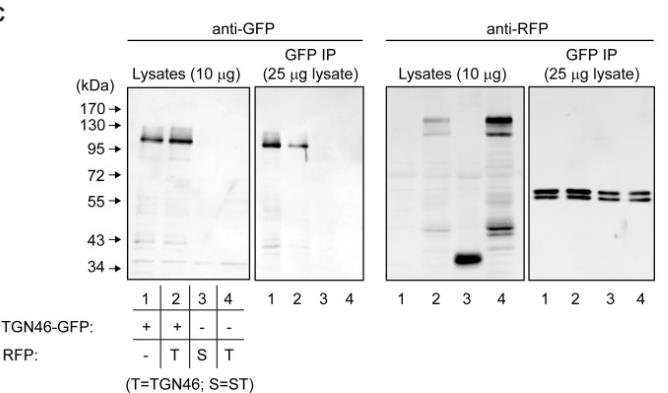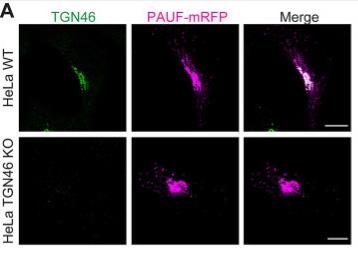TGOLN2
-
Official Full Name
trans-golgi network protein 2 -
Overview
May be involved in regulating membrane traffic to and from trans-Golgi network. -
Synonyms
TGOLN2;trans-golgi network protein 2;TGN41;TGN46;Ttgn2;TGN38B;trans-Golgi network integral membrane protein 2
Recombinant Proteins
- Human
- Mouse
- Rat
- E.coli
- Mammalian Cells
- HEK293
- His
- Non
- DDK
- Myc
- Avi
- Fc
Background
What is TGOLN2 Protein?
TGOLN2 protein is like a cellular jack-of-all-trades, playing a crucial role in managing how cells grow, change, and even self-destruct when necessary. It acts as a regulator for the cell cycle and signaling pathways, ensuring cells know just what to do at various stages. But that's not all—TGOLN2 is also tied to certain health issues. For instance, in some types of cancer, the levels of TGOLN2 might shift, which can have a big impact on how tumor cells grow and spread. Because of this, scientists are delving deeper into understanding exactly how TGOLN2 functions in these diseases. They're aiming to find new ways to treat diseases by figuring out how to control or even stop them from getting worse. By diving deeper into what this complex protein really does, scientists are hopeful they can come up with fresh treatments that truly improve health and recovery.What is the Function of TGOLN2 Protein?
TGOLN2 is a protein that wears many hats in a cell's world. It's crucial for a bunch of stuff, like how cells grow, how they change, and even when they need to self-destruct. One of the big roles of TGOLN2 is in managing the cell cycle, which is how cells decide to split and go through their life's daily grind. It also plays a part in passing messages within cells, making sure everything runs smoothly. But it doesn't stop there. This protein can even be a player in some health conditions. In certain cancers, levels of TGOLN2 can be off-kilter, which messes with how tumor cells behave. Scientists are really diving into TGOLN2 to figure out all the ways it can influence our health, hoping to unlock new treatment possibilities that could change the game for tackling diseases.TGOLN2 Related Signaling Pathway
TGOLN2 is a protein associated with multiple signaling pathways, which are like communication networks in cells. Imagine these pathways as roadmaps that tell cells how to respond to changes, grow, or even self-destruct when needed. TGOLN2 plays a role in managing these signals, especially in pathways that control the cell cycle and other vital functions. When things go wrong with TGOLN2, it can affect these pathways, leading to issues like disrupted cell growth or malfunction. In some cases, this could contribute to diseases, including certain cancers where the signaling goes haywire. Scientists are keen on figuring out exactly how TGOLN2 interacts with these signaling pathways since unlocking these secrets could open doors to new therapies or strategies for managing diseases more effectively. By piecing together how TGOLN2 fits into the bigger cellular picture, researchers hope to develop interventions that could tackle the root causes of various conditions.TGOLN2 Related Diseases
TGOLN2 is linked to various diseases, mainly because it plays a crucial role in cellular processes like growth, signaling, and even death of cells. When there's a mix-up in how TGOLN2 functions, it can cause trouble in these processes, leading to a range of diseases. For example, in certain cancers, the levels of TGOLN2 can be off, affecting how cancer cells grow, spread, or respond to treatments. This makes TGOLN2 a point of interest for researchers who are exploring how these imbalances contribute to disease progression. They aim to understand its exact role, hoping that this insight could lead to breakthrough therapies or strategies to better manage or treat these conditions. By focusing on TGOLN2's role in diseases, scientists are paving the way toward potential new directions in medical treatment.Bioapplications of TGOLN2
TGOLN2 is becoming an intriguing protein for scientists, especially for its potential bioapplications. This protein plays significant roles in how cells manage growth, communication, and even death. Imagine TGOLN2 as a boss regulating crucial aspects of cellular operations, which opens the door to various medical possibilities. In the world of cancer research, for example, TGOLN2 could help us understand tumor behavior better. Its activity might be linked to how tumors grow and spread, making it a target for developing new treatment methods. Researchers are also exploring how TGOLN2 could be harnessed in regenerative medicine. By understanding its role in cell proliferation and organization, scientists hope to use TGOLN2 in tissue repair and engineering. This journey of discovery into TGOLN2's functions and applications might pave the way for novel therapies, offering fresh hope in tackling some of today's most challenging health issues.Case Study
Case Study 1: Lujan P. et al. Elife. 2024
Secretory proteins get ready for export at the trans-Golgi network (TGN), but the details of how this really works are still a bit of a mystery. Recently, researchers discovered that a human protein called TGN46 acts like a receptor for getting secretory proteins like PAUF ready for transport. These proteins move within special carriers that head from the TGN to the plasma membrane, relying on something called protein kinase D. TGN46 is crucial for organizing and loading the secretory proteins into these carriers. Using some smart techniques like fluorescence microscopy and mutagenesis, we found out that the lumenal domain of TGN46 is responsible for this sorting task. Overall, this shows how TGN46 helps sort and export secretory proteins from the TGN.-
 Fig1. TGN46-GFP and TGN46-mRFP do not co-immunoprecipitate.
Fig1. TGN46-GFP and TGN46-mRFP do not co-immunoprecipitate. -
 Fig2. The localization of endogenous TGN46 and PAUF-mRFP was monitored by immunofluorescence microscopy.
Fig2. The localization of endogenous TGN46 and PAUF-mRFP was monitored by immunofluorescence microscopy.
Quality Guarantee
High Purity
-
.jpg) Fig1. SDS-PAGE (TGOLN2-5566H)
Fig1. SDS-PAGE (TGOLN2-5566H) -
.jpg) Fig2. SDS-PAGE (TGOLN2-651H)
Fig2. SDS-PAGE (TGOLN2-651H)
Involved Pathway
TGOLN2 involved in several pathways and played different roles in them. We selected most pathways TGOLN2 participated on our site, such as Clathrin derived vesicle budding,Golgi Associated Vesicle Biogenesis,Membrane Trafficking, which may be useful for your reference. Also, other proteins which involved in the same pathway with TGOLN2 were listed below. Creative BioMart supplied nearly all the proteins listed, you can search them on our site.
| Pathway Name | Pathway Related Protein |
|---|---|
| Clathrin derived vesicle budding | BLOC1S3,CLTA,DTNBP1,FTH1A,PLDN,FTH1B,CLVS1,SNX9A,AP1S3A,PICALMB |
| Golgi Associated Vesicle Biogenesis | FTH1B,DTNBP1,BLOC1S6,PICALMA,AP1S1,HIP1RB,SNX9B,TPD52,PLDN,CNO |
| trans-Golgi Network Vesicle Budding | SNAPIN,PICALM,TCEAL4,YIPF6,BLOC1S4,FTH1B,TPD52L1,SNX9,CNO,SNX9B |
| Vesicle-mediated transport | SCGB3A2,TRAPPC6B,TRAPPC2L,LOC479668,RALAA,MIA3,STXBP3,SNX9A,NAPB,PICALMA |
| Membrane Trafficking | EXOC1,COPB2,MYO6A,SNAPIN,AP4B1,GJB3,NECAP1,GORASP1,DNASE2,MCFD2 |
Protein Function
TGOLN2 has several biochemical functions, for example, protein binding. Some of the functions are cooperated with other proteins, some of the functions could acted by TGOLN2 itself. We selected most functions TGOLN2 had, and list some proteins which have the same functions with TGOLN2. You can find most of the proteins on our site.
| Function | Related Protein |
|---|---|
| protein binding | PNKP,HNRNPUL1,TIMM23,KLF15,ZNF664-FAM101A,DIAPH1,SH2D3A,SPON2,MVP,MASP1 |
Interacting Protein
TGOLN2 has direct interactions with proteins and molecules. Those interactions were detected by several methods such as yeast two hybrid, co-IP, pull-down and so on. We selected proteins and molecules interacted with TGOLN2 here. Most of them are supplied by our site. Hope this information will be useful for your research of TGOLN2.
KRTAP10-9;ABL1;FYN;NCK1;PLCG1;PIK3R1;CRK;GRB2;AP2B1;PKMYT1;FURIN;IGF2R;MMP14;ATG9A;SYT2;NCSTN
Resources
Related Services
Related Products
References


